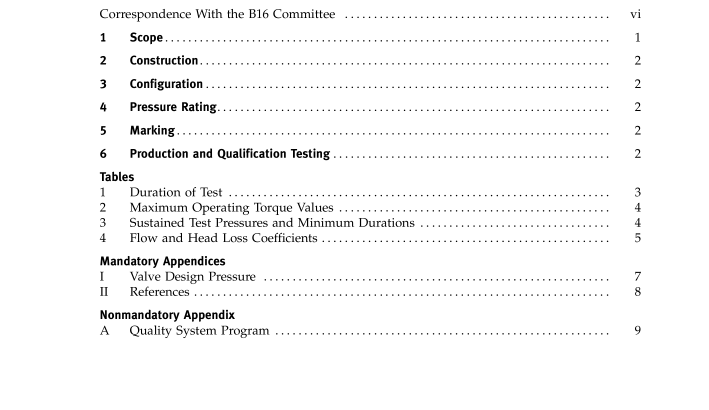ASME B16.40-2008 pdf free download.Manually Operated Thermoplastic Gas Shutoffs and Valves in Gas Distribution Systems
6.2 Production Testing
6.2.1 Shell Test. Each valve shall be tested at 4 psi ± 2 psi (0.28 bar ± 0.14 bar) and ata minimumof1.5 times the design pressure. The test pressure shall be applied to all pressure-containing areas of the valve (including stem seals and valve ends). This may require that the valve be in the partially open position. The shell test shall be conducted at a temperature of 73°F ± 15°F (23°C ± 8°C). The test fixturing shall not restrain the valve against any mode of failure or leakage. The minimum duration of each of the two shell tests shall be as shown in Table 1. 6.2.2 Seat Test. Each valve shall be seat closure tested at 4 psi ± 2 psi (0.28 bar ± 0.14 bar) and at a minimum of 1.5 times the valve design pressure. These pressures shall be applied successively on each side of the valve seat(s) to check the valve-sealing performance in both directions. The seat test shall be conducted at a temperature of 73°F ± 15°F (23°C ± 8°C). The seat test’s fixturing shall not restrain the valve against any mode of failure or leakage. The minimum duration of each portion of the test shall be as shown in Table 1.
6.3 Qualification Testing
6.3.1 OperationalTest. Itshall be demonstrated that each nominal size of each basic valve design is capable of successfully passing the seat leakage tests of para. 6.2.2, after having completed ten fully opened/closed cycles at 73°F ± 15°F (23°C ± 8°C). The valve shall be pressurized with air or other gas to the design pressure at one port with the other port open to atmosphere before opening on each cycle. At the start of each cycle, the operating torque shall be measured and not exceed those in Table 2 for −20°F (−29°C).
6.3.2 Temperature Resistance. It shall be demonstrated that each nominal size of each basic valve design is capable of being operated at temperatures of −20°F ± 5°F (−29°C ± 3°C) and 140°F ± 5°F (60°C ± 3°C) without visible leakage to atmosphere and without affecting the internal seat-sealing performance of the valve. The method of test is as follows. A closed valve shall be cooled to a temperature of −20°F ± 5°F (−29°C ± 3°C) and held there for an 18-hr minimum. The valve shall then be pressurized with air or gas to a differential pres- sure across the seat equal to the valve design pressure. The valve shall then be opened against the applied- differential pressure, using a torque less than or equal to that of Table 2 at the −20°F (−29°C) values and then closed (no differential pressure across the seat required). The valve shall then be tested to meet the requirements of para. 6.2 while at −20°F (−29°C), except nonfreezing leak-detection agents shall be used. The valve shall then be heated to a temperature of 140°F ± 5°F (60°C ± 3°C) and held there for an 18-hr minimum.
The closed valve shall then be pressurized with air or other gas to a differential pressure across the seat equal to the valve’s design pressure at 140°F (60°C). The valve shall then be opened against the applied-differential pressure using a torque less than or equal to that of Table 2 [140°F (60°C)] values and then closed (no differential pressure across the seat required). The valve shall then be tested to and meet the requirements of para. 6.2, while at 140°F (60°C). 6.3.3 Sustained-Pressure Test. Each basic valve design shall be subjected to the sustained-pressure tests described herein to evaluate the long-term pressure integrity of the valve shell and closure elements. All valves shall be in the open position for the Pressure- Boundary Test [see para. 6.3.3(a)] and in the closed posi- tion for the Closure Verification Test [see para. ASME B16.40 pdf download.ASME B16.40-2008 pdf free download
